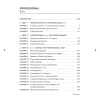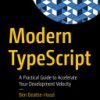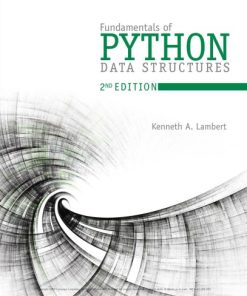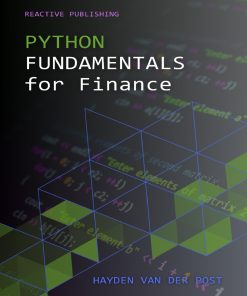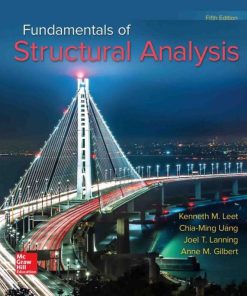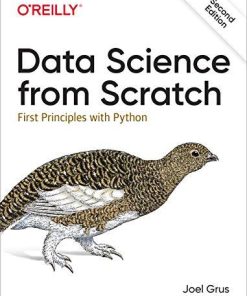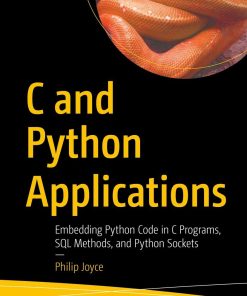Fundamentals of Python First Programs 2nd Edition by Kenneth Lambert 9798214344317
$50.00 Original price was: $50.00.$25.00Current price is: $25.00.
Fundamentals of Python: First Programs 2nd Edition by Kenneth A. Lambert – Ebook PDF Instant Download/DeliveryISBN: 9798214344317
Full download Fundamentals of Python: First Programs 2nd Edition after payment.
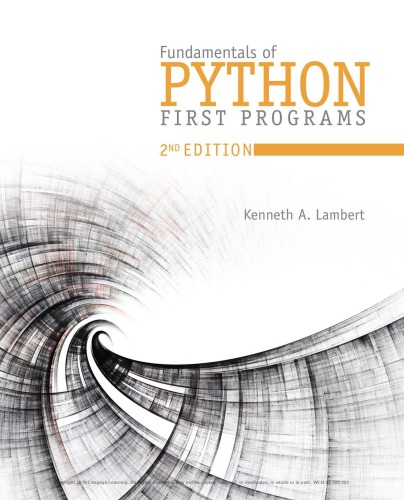
Product details:
ISBN-13 : 9798214344317
Author : Kenneth A. Lambert
Master today’s required computer science topics while preparing for further study with Lambert’s FUNDAMENTALS OF PYTHON: FIRST PROGRAMS. This book’s easygoing approach is ideal, no matter what your background. The approach starts with simple algorithmic code and then scales into working with functions, objects, and classes as the problems become more complex and require new abstraction mechanisms. Rather than working only with numeric or text-based applications like other introductory texts, this edition presents graphics, image manipulation, GUIs, and simple networked client/server applications. The author uses Python’s standard Turtle graphics module to introduce graphics and to provide open source frameworks for easy image processing and GUI application development.
Fundamentals of Python: First Programs 2nd Table of contents:
Chapter 1. Introduction
Two Fundamental Ideas of Computer Science: Algorithms and Information Processing
Algorithms
Information Processing
The Structure of a Modern Computer System
Computer Hardware
Computer Software
A Not-So-Brief History of Computing Systems
Before Electronic Digital Computers
The First Electronic Digital Computers (1940–1950)
The First Programming Languages (1950–1965)
Integrated Circuits, Interaction, and Timesharing (1965–1975)
Personal Computing and Networks (1975–1990)
Consultation, Communication, and E-Commerce (1990–2000)
Mobile Applications and Ubiquitous Computing (2000–present)
Getting Started with Python Programming
Running Code in the Interactive Shell
Input, Processing, and Output
Editing, Saving, and Running a Script
Behind the Scenes: How Python Works
Detecting and Correcting Syntax Errors
Suggestions for Further Reading
Summary
Review Questions
Projects
Chapter 2. Software Development, Data Types, and Expressions
The Software Development Process
Strings, Assignment, and Comments
Data Types
String Literals
Escape Sequences
String Concatenation
Variables and the Assignment Statement
Program Comments and Docstrings
Numeric Data Types and Character Sets
Integers
Floating-Point Numbers
Character Sets
Expressions
Arithmetic Expressions
Mixed-Mode Arithmetic and Type Conversions
Using Functions and Modules
Calling Functions: Arguments and Return Values
The math Module
The Main Module
Program Format and Structure
Running a Script from a Terminal Command Prompt
Summary
Review Questions
Projects
Chapter 3. Loops and Selection Statements
Definite Iteration: The for Loop
Executing a Statement a Given Number of Times
Count-Controlled Loops
Augmented Assignment
Loop Errors: Off-by-One Error
Traversing the Contents of a Data Sequence
Specifying the Steps in the Range
Loops That Count Down
Formatting Text for Output
Selection: if and if-else Statements
The Boolean Type, Comparisons, and Boolean Expressions
if-else Statements
One-Way Selection Statements
Multi-Way if Statements
Logical Operators and Compound Boolean Expressions
Short-Circuit Evaluation
Testing Selection Statements
Conditional Iteration: The while Loop
The Structure and Behavior of a while Loop
Count Control with a while Loop
The while True Loop and the break Statement
Random Numbers
Loop Logic, Errors, and Testing
Summary
Review Questions
Projects
Chapter 4. Strings and Text Files
Accessing Characters and Substrings in Strings
The Structure of Strings
The Subscript Operator
Slicing for Substrings
Testing for a Substring with the in Operator
Data Encryption
Strings and Number Systems
The Positional System for Representing Numbers
Converting Binary to Decimal
Converting Decimal to Binary
Conversion Shortcuts
Octal and Hexadecimal Numbers
String Methods
Text Files
Text Files and Their Format
Writing Text to a File
Writing Numbers to a File
Reading Text from a File
Reading Numbers from a File
Accessing and Manipulating Files and Directories on Disk
Summary
Review Questions
Projects
Chapter 5. Lists and Dictionaries
Lists
List Literals and Basic Operators
Replacing an Element in a List
List Methods for Inserting and Removing Elements
Searching a List
Sorting a List
Mutator Methods and the Value None
Aliasing and Side Effects
Equality: Object Identity and Structural Equivalence
Example: Using a List to Find the Median of a Set of Numbers
Tuples
Defining Simple Functions
The Syntax of Simple Function Definitions
Parameters and Arguments
The return Statement
Boolean Functions
Defining a main Function
Dictionaries
Dictionary Literals
Adding Keys and Replacing Values
Accessing Values
Removing Keys
Traversing a Dictionary
Example: The Hexadecimal System Revisited
Example: Finding the Mode of a List of Values
Summary
Review Questions
Projects
Chapter 6. Design with Functions
A Quick Review of What Functions Are and How They Work
Functions as Abstraction Mechanisms
Functions Eliminate Redundancy
Functions Hide Complexity
Functions Support General Methods with Systematic Variations
Functions Support the Division of Labor
Problem Solving with Top-Down Design
The Design of the Text-Analysis Program
The Design of the Sentence-Generator Program
The Design of the Doctor Program
Design with Recursive Functions
Defining a Recursive Function
Tracing a Recursive Function
Using Recursive Definitions to Construct Recursive Functions
Recursion in Sentence Structure
Infinite Recursion
The Costs and Benefits of Recursion
Managing a Program’s Namespace
Module Variables, Parameters, and Temporary Variables
Scope
Lifetime
Using Keywords for Default and Optional Arguments
Higher-Order Functions
Functions as First-Class Data Objects
Mapping
Filtering
Reducing
Using lambda to Create Anonymous Functions
Creating Jump Tables
Summary
Review Questions
Projects
Chapter 7. Simple Graphics and Image Processing
Simple Graphics
Overview of Turtle Graphics
Turtle Operations
Setting Up a turtle.cfg File and Running IDLE
Object Instantiation and the turtle Module
Drawing Two-Dimensional Shapes
Examining an Object’s Attributes
Manipulating a Turtle’s Screen
Taking a Random Walk
Colors and the RGB System
Example: Filling Radial Patterns with Random Colors
Image Processing
Analog and Digital Information
Sampling and Digitizing Images
Image File Formats
Image-Manipulation Operations
The Properties of Images
The images Module
A Loop Pattern for Traversing a Grid
A Word on Tuples
Converting an Image to Black and White
Converting an Image to Grayscale
Copying an Image
Blurring an Image
Edge Detection
Reducing the Image Size
Summary
Review Questions
Projects
Chapter 8. Graphical User Interfaces
The Behavior of Terminal-Based Programs and GUI-Based Programs
The Terminal-Based Version
The GUI-Based Version
Event-Driven Programming
Coding Simple GUI-Based Programs
A Simple “Hello World” Program
A Template for All GUI Programs
The Syntax of Class and Method Definitions
Subclassing and Inheritance as Abstraction Mechanisms
Windows and Window Components
Windows and Their Attributes
Window Layout
Types of Window Components and Their Attributes
Displaying Images
Command Buttons and Responding to Events
Input and Output with Entry Fields
Text Fields
Integer and Float Fields for Numeric Data
Using Pop-Up Message Boxes
Defining and Using Instance Variables
Other Useful GUI Resources
Using Nested Frames to Organize Components
Multi-Line Text Areas
File Dialogs
Obtaining Input with Prompter Boxes
Check Buttons
Radio Buttons
Keyboard Events
Working with Colors
Using a Color Chooser
Summary
Review Questions
Projects
Chapter 9. Design with Classes
Getting Inside Objects and Classes
A First Example: The Student Class
Docstrings
Method Definitions
The __init__ Method and Instance Variables
The __str__ Method
Accessors and Mutators
The Lifetime of Objects
Rules of Thumb for Defining a Simple Class
Data-Modeling Examples
Rational Numbers
Rational Number Arithmetic and Operator Overloading
Comparison Methods
Equality and the __eq__ Method
Savings Accounts and Class Variables
Putting the Accounts into a Bank
Using pickle for Permanent Storage of Objects
Input of Objects and the try-except Statement
Playing Cards
Building a New Data Structure: The Two-Dimensional Grid
The Interface of the Grid Class
The Implementation of the Grid Class: Instance Variables for the Data
The Implementation of the Grid Class: Subscript and Search
Structuring Classes with Inheritance and Polymorphism
Inheritance Hierarchies and Modeling
Example 1: A Restricted Savings Account
Example 2: The Dealer and a Player in the Game of Blackjack
Polymorphic Methods
The Costs and Benefits of Object-Oriented Programming
Summary
Review Questions
Projects
Chapter 10. Multithreading, Networks, and Client/Server Programming
Threads and Processes
Threads
Sleeping Threads
Producer, Consumer, and Synchronization
The Readers and Writers Problem
Using the SharedCell Class
Implementing the Interface of the SharedCell Class
Implementing the Helper Methods of the SharedCell Class
Testing the SharedCell Class with a Counter Object
Defining a Thread-Safe Class
Networks, Clients, and Servers
IP Addresses
Ports, Servers, and Clients
Sockets and a Day/Time Client Script
A Day/Time Server Script
A Two-Way Chat Script
Handling Multiple Clients Concurrently
Summary
Review Questions
Projects
Chapter 11. Searching, Sorting, and Complexity Analysis
Measuring the Efficiency of Algorithms
Measuring the Run Time of an Algorithm
Counting Instructions
Complexity Analysis
Orders of Complexity
Big-O Notation
The Role of the Constant of Proportionality
Measuring the Memory Used by an Algorithm
Search Algorithms
Search for a Minimum
Sequential Search of a List
Best-Case, Worst-Case, and Average-Case Performance
Binary Search of a List
Basic Sort Algorithms
Selection Sort
Bubble Sort
Insertion Sort
Best-Case, Worst-Case, and Average-Case Performance Revisited
Faster Sorting
Quicksort
Merge Sort
An Exponential Algorithm: Recursive Fibonacci
Converting Fibonacci to a Linear Algorithm
Summary
Review Questions
People also search for Fundamentals of Python: First Programs 2nd:
kenneth a lambert fundamentals of python pdf
fundamentals of python first programs 3rd edition pdf
fundamentals of python first programs 3rd edition
fundamentals of python first programs pdf
learn fundamentals of python
Tags: Fundamentals, Python, First Programs, Kenneth Lambert
You may also like…
Computers - Programming
Fundamentals Of Python: Data Structures 2nd Edition by Kenneth Lambert 8214344324 9798214344324
Computers & Technology
Python Fundamentals for Finance: A survey of Algorithmic Options trading with Hayden Van Der Post
Medicine - Nursing
Medicine - Anatomy and physiology
Essentials of Anatomy & Physiology, 2nd Edition Kenneth S. Saladin
Computers - Programming
Uncategorized
Engineering - Civil & Structural Engineering
Fundamentals of Structural Analysis Solution Manual 5th edition Kenneth M. Leet


